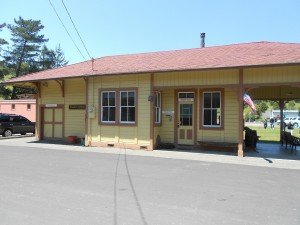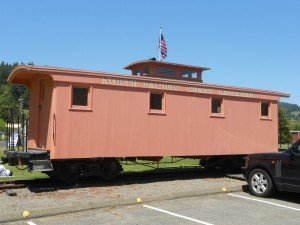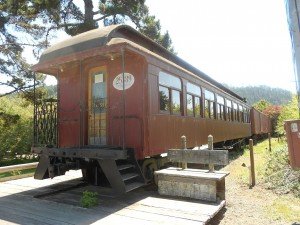The North Pacific Coast Railroad was one of those railroads that came about because of the expansion along the west coast, and in particular, the building out of the San Francisco Bay area. The railroad was a narrow gauge common carrier that ran between Sausalito California and northward to Cazadaro California very near the Pacific coast. The rail line was connected to San Francisco proper via the ferry at Sausalito. The total length of the railroad line was 93 miles. During it’s latter years the railroad was called the Northwest Pacific Railroad.
Thank you for reading this post, don't forget to subscribe!
The Sonoma railroad is filled with northern California history. California railroads were key to the growing lumber industry. The North Pacific Coast Railroad started in operation in 1874. One of it’s purposes was to haul lumber down to the Bay Area.
The area north of the San Francisco Bay along the California coastline is filled with beautiful redwood trees and the North Pacific Coast Railroad earned a lot of money hauling lumber. One of the largest lumber mills was located in Duncan Mills just a few miles inland from the coast and at the end of the line. As a result, Duncan Mills, which today is a nice small tourist village, was a busy commercial site. Buildings were erected right and left and included three beautiful Victorian hotels.
During it’s heyday, Duncan Mills had many eastern visitors including Ulysses S. Grant. The Bay Area was booming and wood homes were being built at a feverish pace. In summertime during the early 1900’s railroad travel was very popular. Lines of people would get their ticket at the San Francisco Ferry Building. Some were vacationers and others were looking for a same day excursion up to the beautiful Russian River area.
The town received it’s name from the brothers who started lumber operations in the area, Sam and Alex Duncan. What grew their business and what put Duncan Mills on the map was the North Pacific Coast Railroad. The arrival of the railroad introduced many more visitors to the area provided a means to ship large quantities of lumber. When the railroad came to town in 1876, Duncan Mills had a post office, a hotel and four saloons. As Alex Duncan owned lands heavily forested on both sides of the Russian River, he came into an agreement to move his lumber mill to the north side of the river if the North Pacific Coast Railroad would build a railroad bridge from Moscow Mills, located on the south side of the river to reach his properties.
The first train arrived in the new town of Duncan Mills in 1877, and the depot became the northernmost terminus on the line. Today, the tourist can visit the Duncan Mills railroad station which is still at it’s original location.The depot was constructed in 1907 and won the outstanding restoration award for the State of California in 1971.

One of the old rail cars on display at Duncan Mills is the North Pacific Coast Railroad Caboose NO. 2. This narrow gauge caboose car was built in 1877 at the North Pacific Coast R. R. Sausalito shops. It was added to the line that same year.
Records are that this was the only caboose manufactured by the railroad. Another rail car is a wooden built coach that operated on the North Pacific Coast Railroad until it’s last days.
Steam trains were a common sight in this area of Sonoma County. The “Sonoma” is one of three locomotives built in 1876 by the Baldwin Locomotive Works of Philadelphia for the narrow gauge North Pacific Coast Railroad. This engine which is now on display at the California State Railroad Museum in Sacramento California hauled both passengers and freight on the line from Sausalito to Duncan Mills. The Sacramento Railroad Museum is probably one of the very best in the United States.
During the 1906 earthquake, Duncan Mills lost it’s three Victorian hotels. Essentially the entire village was destroyed and was left to the sprouting weeds for years to come. The North Pacific Coast Railroad ceased operations in 1925 for a variety of reasons. The redwood trees were being depleted and a massive fire that burned from Guerneville to the Pacific coast hurried the process. In addition to this, automobiles began hitting the road and the train was used less and less.

Today, the tourist to Duncan Mills and the lower Russian River region can see some of the old railroad cars still on display as well as the railroad depot. Duncan Mills also offers restaurants, unique shops and a fine wine tasting room.
Driving the popular River Road all the way from U.S. Hwy 101 offers a very scenic drive. The towns along this stretch of the Russian River are now northern CA resorts. River Road essentially follows the meandering Russian River as it heads to it’s mouth at the Pacific Ocean just a bit west of Duncan Mills. Duncan Mills is located 5 miles east of the Pacific Coast Highway 1.
Two additional related travel stops in northern California are the Luther Burbank Home and Gardens in Santa Rosa California and Kayaking on the Russian River.
If you’re going to travel northern California, this area along the lower Russian River between Hwy 101 and the ocean is a good addition to your California road trip planner. Duncan Mills, Guerneville, Occidental and other historic towns in the redwood country north of the San Francisco Bay area continue to be popular summer destinations for kayaking, canoeing, camping and just fun relaxation in the fresh outdoors that the redwoods and ocean offer.
The most direct way to reach the Russian River vacation town of Duncan Mills is to travel north on U.S. Hwy 101 from San Francisco and exit at River Road which is just on the north side of Santa Rosa, about 65 miles north of the Golden Gate Bridge. Turn left onto River Road and drive west about 25 miles.
(Article and photos copyright Trips Into History)

